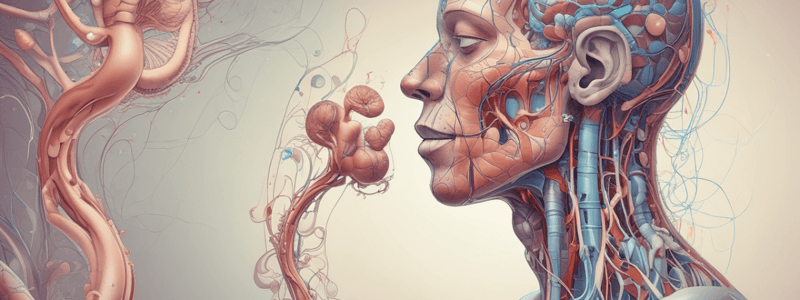Podcast
Questions and Answers
Which of the following bacteria is not typically found in the nasal cavity?
Which of the following bacteria is not typically found in the nasal cavity?
What is the main function of the mucociliary escalator in the respiratory system?
What is the main function of the mucociliary escalator in the respiratory system?
Which of the following is a characteristic of Veillonella spp.?
Which of the following is a characteristic of Veillonella spp.?
What is the main difference between the upper and lower respiratory systems in terms of microbiota?
What is the main difference between the upper and lower respiratory systems in terms of microbiota?
Signup and view all the answers
Which of the following bacteria requires X Factor and V Factor for growth?
Which of the following bacteria requires X Factor and V Factor for growth?
Signup and view all the answers
What is the main function of alveolar macrophages in the respiratory system?
What is the main function of alveolar macrophages in the respiratory system?
Signup and view all the answers
Which of the following is not a type of bacteria found in the pharynx?
Which of the following is not a type of bacteria found in the pharynx?
Signup and view all the answers
What is the name of the structure that separates the right and left main bronchi?
What is the name of the structure that separates the right and left main bronchi?
Signup and view all the answers
What is the primary cause of 'Strep Throat'?
What is the primary cause of 'Strep Throat'?
Signup and view all the answers
What is a virulence factor of Streptococcus pyogenes?
What is a virulence factor of Streptococcus pyogenes?
Signup and view all the answers
What is a characteristic of Streptococcus pyogenes?
What is a characteristic of Streptococcus pyogenes?
Signup and view all the answers
What is a common symptom of streptococcal pharyngitis?
What is a common symptom of streptococcal pharyngitis?
Signup and view all the answers
Which of the following bacteria is normally found in the pharynx and nasal cavity?
Which of the following bacteria is normally found in the pharynx and nasal cavity?
Signup and view all the answers
What is a benefit of the upper respiratory microbiome?
What is a benefit of the upper respiratory microbiome?
Signup and view all the answers
What is a characteristic of Streptococcus pneumoniae?
What is a characteristic of Streptococcus pneumoniae?
Signup and view all the answers
What is a complication of Staphylococcus aureus infection?
What is a complication of Staphylococcus aureus infection?
Signup and view all the answers
Study Notes
Microbiology of Upper Respiratory Tract
- Upper respiratory system has a diverse microbiome, while lower respiratory system is free of resident microbiota.
- Nasal cavity microbiome consists of Haemophilus bacteria, Veillonella bacteria, and diphtheroid.
- Pharynx microbiome consists of Staphylococcus bacteria, Streptococcus bacteria, and diphtheroid.
Normal Microbiome of Pharynx and Nasal Cavity
-
Haemophilus spp. require X Factor (Hemin) and V Factor (NAD+).
-
Haemophilus influenzae is a type of Haemophilus spp.
-
Veillonella spp. are Gram-negative, anaerobic, and potent lactate fermenters and nitrate reducers.
-
Veillonella parvula is an example of Veillonella spp.
-
Staphylococcus aureus can cause various diseases, including pneumonia, meningitis, osteomyelitis, toxic shock syndrome, sepsis, scalded skin syndrome, folliculitis, and pimples.
-
Diphtheroids include Corynebacterium diptheriae and Propionibacterium acnes.
-
Alpha-hemolytic streptococci do not cause complete hemolysis of red blood cells, unlike beta-hemolytic streptococci.
-
Streptococcus pneumoniae and Streptococcus pyogenes are examples of alpha-hemolytic streptococci.
Pros and Cons of Upper Respiratory Microbiome
- The upper respiratory microbiome limits infection, but it also provides opportunities for opportunistic pathogens to thrive.
Bacterial Pharyngitis
- Streptococcal pharyngitis, also known as 'strep throat', is characterized by symptoms such as pain during swallowing, bad breath, fever, malaise, and headache.
Causative Agent: Streptococcus pyogenes
- Streptococcus pyogenes is a Gram-positive, facultative anaerobe, and a Lancefield Group A Streptococcus.
- It is beta-hemolytic, meaning it causes complete hemolysis of red blood cells.
Streptococcus pyogenes: Virulence Factors
- M protein is a C3b inhibitor, which helps the bacteria evade the immune system.
- Hyaluronic acid capsule and streptokinases are virulence factors that contribute to the bacteria's ability to cause disease.
- C5a peptidase and pyrogenic (erythrogenic) toxins are also virulence factors of Streptococcus pyogenes.
- Streptolysin O is a hemolysin that causes hemolysis of red blood cells.
Studying That Suits You
Use AI to generate personalized quizzes and flashcards to suit your learning preferences.
Related Documents
Description
Explore the microbiome of the upper respiratory tract, including normal microbiota, bacterial pharyngitis, and viral diseases. Review respiratory anatomy and understand the significance of the nasal cavity, oral cavity, pharynx, and larynx.




